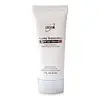What's inside
What's inside
 Key Ingredients
Key Ingredients

 Benefits
Benefits

 Concerns
Concerns

 Ingredients Side-by-side
Ingredients Side-by-side

Water
Skin ConditioningHomosalate
Skin ConditioningAlcohol Denat.
AntimicrobialButyl Methoxydibenzoylmethane
UV AbsorberBis-Ethylhexyloxyphenol Methoxyphenyl Triazine
Skin ConditioningHexyl Salicylate
MaskingDibutyl Adipate
EmollientEthylhexyl Triazone
UV AbsorberCopernicia Cerifera Wax
Panthenol
Skin ConditioningGlycerin
HumectantSilica
AbrasiveVp/Hexadecene Copolymer
Microcrystalline Cellulose
AbsorbentSucrose Polystearate
EmollientTetrasodium Iminodisuccinate
Cellulose Gum
Emulsion StabilisingButylene Glycol Dicaprylate/Dicaprate
EmollientDistarch Phosphate
AbsorbentPhenylbenzimidazole Sulfonic Acid
UV AbsorberPolyglyceryl-4 Isostearate
EmulsifyingAcrylates/C10-30 Alkyl Acrylate Crosspolymer
Emulsion StabilisingSodium Stearoyl Glutamate
CleansingEthylhexylglycerin
Skin ConditioningCaprylyl Glycol
EmollientHydrogenated Polyisobutene
EmollientTrisodium EDTA
Xanthan Gum
EmulsifyingSodium Hydroxide
BufferingSimmondsia Chinensis Seed Oil
EmollientTocopheryl Acetate
AntioxidantAloe Ferox Leaf Juice Powder
Skin ConditioningSodium Chloride
MaskingWater, Homosalate, Alcohol Denat., Butyl Methoxydibenzoylmethane, Bis-Ethylhexyloxyphenol Methoxyphenyl Triazine, Hexyl Salicylate, Dibutyl Adipate, Ethylhexyl Triazone, Copernicia Cerifera Wax, Panthenol, Glycerin, Silica, Vp/Hexadecene Copolymer, Microcrystalline Cellulose, Sucrose Polystearate, Tetrasodium Iminodisuccinate, Cellulose Gum, Butylene Glycol Dicaprylate/Dicaprate, Distarch Phosphate, Phenylbenzimidazole Sulfonic Acid, Polyglyceryl-4 Isostearate, Acrylates/C10-30 Alkyl Acrylate Crosspolymer, Sodium Stearoyl Glutamate, Ethylhexylglycerin, Caprylyl Glycol, Hydrogenated Polyisobutene, Trisodium EDTA, Xanthan Gum, Sodium Hydroxide, Simmondsia Chinensis Seed Oil, Tocopheryl Acetate, Aloe Ferox Leaf Juice Powder, Sodium Chloride
Homosalate 7.5%
Skin ConditioningEthylhexyl Salicylate 4.5%
UV AbsorberTitanium Dioxide 2.2%
Cosmetic ColorantZinc Oxide 12.7%
Cosmetic ColorantWater
Skin ConditioningCyclopentasiloxane
EmollientDipropylene Glycol
HumectantDisiloxane
Skin ConditioningLauryl PEG-10 Tris(Trimethylsiloxy)Silylethyl Dimethicone
EmulsifyingGlycerin
HumectantNiacinamide
SmoothingPropylheptyl Caprylate
EmollientPortulaca Oleracea Extract
Skin ConditioningSilica
AbrasiveDimethicone
EmollientDisteardimonium Hectorite
StabilisingMagnesium Sulfate
1,2-Hexanediol
Skin ConditioningVinyl Dimethicone/Methicone Silsesquioxane Crosspolymer
Triethoxycaprylylsilane
Aluminum Hydroxide
EmollientStearic Acid
CleansingSorbitan Caprylate
EmulsifyingDimethicone/PEG-10/15 Crosspolymer
Parfum
MaskingDimethicone/Vinyl Dimethicone Crosspolymer
Skin ConditioningGlyceryl Caprylate
EmollientEthylhexylglycerin
Skin ConditioningAdenosine
Skin ConditioningTocopherol
AntioxidantCamellia Sinensis Leaf Extract
AntimicrobialMelilotus Officinalis Extract
AstringentCentella Asiatica Extract
CleansingPerilla Ocymoides Leaf Extract
TonicHomosalate 7.5%, Ethylhexyl Salicylate 4.5%, Titanium Dioxide 2.2%, Zinc Oxide 12.7%, Water, Cyclopentasiloxane, Dipropylene Glycol, Disiloxane, Lauryl PEG-10 Tris(Trimethylsiloxy)Silylethyl Dimethicone, Glycerin, Niacinamide, Propylheptyl Caprylate, Portulaca Oleracea Extract, Silica, Dimethicone, Disteardimonium Hectorite, Magnesium Sulfate, 1,2-Hexanediol, Vinyl Dimethicone/Methicone Silsesquioxane Crosspolymer, Triethoxycaprylylsilane, Aluminum Hydroxide, Stearic Acid, Sorbitan Caprylate, Dimethicone/PEG-10/15 Crosspolymer, Parfum, Dimethicone/Vinyl Dimethicone Crosspolymer, Glyceryl Caprylate, Ethylhexylglycerin, Adenosine, Tocopherol, Camellia Sinensis Leaf Extract, Melilotus Officinalis Extract, Centella Asiatica Extract, Perilla Ocymoides Leaf Extract
 Reviews
Reviews

Ingredients Explained
These ingredients are found in both products.
Ingredients higher up in an ingredient list are typically present in a larger amount.
Ethylhexylglycerin (we can't pronounce this either) is commonly used as a preservative and skin softener. It is derived from glyceryl.
You might see Ethylhexylglycerin often paired with other preservatives such as phenoxyethanol. Ethylhexylglycerin has been found to increase the effectiveness of these other preservatives.
Glycerin is already naturally found in your skin. It helps moisturize and protect your skin.
A study from 2016 found glycerin to be more effective as a humectant than AHAs and hyaluronic acid.
As a humectant, it helps the skin stay hydrated by pulling moisture to your skin. The low molecular weight of glycerin allows it to pull moisture into the deeper layers of your skin.
Hydrated skin improves your skin barrier; Your skin barrier helps protect against irritants and bacteria.
Glycerin has also been found to have antimicrobial and antiviral properties. Due to these properties, glycerin is often used in wound and burn treatments.
In cosmetics, glycerin is usually derived from plants such as soybean or palm. However, it can also be sourced from animals, such as tallow or animal fat.
This ingredient is organic, colorless, odorless, and non-toxic.
Glycerin is the name for this ingredient in American English. British English uses Glycerol/Glycerine.
Learn more about GlycerinHomosalate is a chemical sunscreen filter that provides protection in the UV-B range (280nm - 320 nm), with a peak protection at 306 nm. It is internationally approved for use in sunscreens.
Homosalate is not photo-stable, meaning it's strength as a UV filter degrades over time with exposure to the sun. Because of this, it's often used in combination with other chemical sunscreen filters as avobenzone (which protects from the UV-A range). Homosalate also helps act as a solvent for harder-to-dissolve UV filters.
(Part of the reason that sunscreens need to be frequently re-applied is due to the photo instability of many chemical sunscreen filters)
Currently, homosalate is approved in concentrations up to 10% in the EU and 15% in the US. The FDA is currently doing further research on the effects of homosalate, and it is possible that these approved concentrations will change in the future.
Learn more about HomosalateSilica, also known as silicon dioxide, is a naturally occurring mineral. It is used as a fine, spherical, and porous powder in cosmetics.
Though it has exfoliant properties, the function of silica varies depending on the product.
The unique structure of silica enhances the spreadability and adds smoothness, making it a great texture enhancer.
It is also used as an active carrier, emulsifier, and mattifier due to its ability to absorb excess oil.
In some products, tiny microneedles called spicules are made from silica or hydrolyzed sponge. When you rub them in, they lightly polish away dead skin layers and enhance the penetration of active ingredients.
Learn more about SilicaWater. It's the most common cosmetic ingredient of all. You'll usually see it at the top of ingredient lists, meaning that it makes up the largest part of the product.
So why is it so popular? Water most often acts as a solvent - this means that it helps dissolve other ingredients into the formulation.
You'll also recognize water as that liquid we all need to stay alive. If you see this, drink a glass of water. Stay hydrated!
Learn more about Water